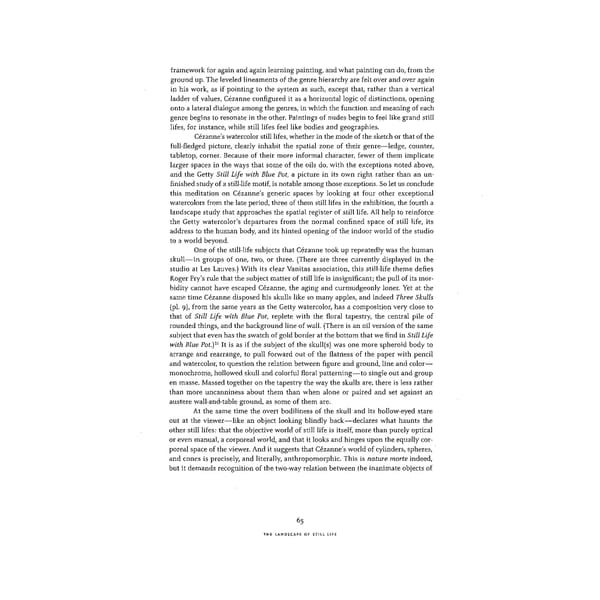framework for again and again learning painting, and what painting can do, from the ground up. The leveled lineaments of the genre hierarchy are felt over and over again in his work, as if pointing to the system as such, except that, rather than a vertical ladder of values, Cézanne configured it as a horizontal logic of distinctions, opening onto a lateral dialogue among the genres, in which the function and meaning of each genre begins to resonate in the other. Paintings of nudes begin to feel like grand still lifes, for instance, while still lifes feel like bodies and geographies. Cezanne's watercolor still lifes, whether in the mode of the sketch or that of the full-fledged picture, clearly inhabit the spatial zone of their genre—ledge, counter, tabletop, corner. Because of their more informal character, fewer of them implicate larger spaces in the ways that some of the oils do, with the exceptions noted above, and the Getty Still Life with Blue Pot, a picture in its own right rather than an un- finished study of a still-life motif, is notable among those exceptions. So let us conclude this meditation on Cezanne's generic spaces by looking at four other exceptional watercolors from the late period, three of them still lifes in the exhibition, the fourth a landscape study that approaches the spatial register of still life. All help to reinforce the Getty watercolor's departures from the normal confined space of still life, its address to the human body, and its hinted opening of the indoor world of the studio to a world beyond. One of the still-life subjects that Cézanne took up repeatedly was the human skull—in groups of one, two, or three. (There are three currently displayed in the studio at Les Lauves.) With its clear Vanitas association, this still-life theme defies Roger Fry's rule that the subject matter of still life is insignificant; the pull of its mor- bidity cannot have escaped Cézanne, the aging and curmudgeonly loner. Yet at the same time Cézanne disposed his skulls like so many apples, and indeed Three Skulls (pi. 9), from the same years as the Getty watercolor, has a composition very close to that of Still Life with Blue Foi, replete with the floral tapestry, the central pile of rounded things, and the background line of wall. (There is an oil version of the same subject that even has the swatch of gold border at the bottom that we find in Still Life 21 with Blue Pot) It is as if the subject of the skull(s) was one more spheroid body to arrange and rearrange, to pull forward out of the flatness of the paper with pencil and watercolor, to question the relation between figure and ground, line and color— monochrome, hollowed skull and colorful floral patterning—to single out and group en masse. Massed together on the tapestry the way the skulls are, there is less rather than more uncanniness about them than when alone or paired and set against an austere wall-and-table ground, as some of them are. At the same time the overt bodiliness of the skull and its hollow-eyed stare out at the viewer—like an object looking blindly back—declares what haunts the other still lifes: that the objective world of still life is itself, more than purely optical or even manual, a corporeal world, and that it looks and hinges upon the equally cor- poreal space of the viewer. And it suggests that Cezanne's world of cylinders, spheres, and cones is precisely, and literally, anthropomorphic/This is nature morte indeed, but it demands recognition of the two-way relation between the inanimate objects of 65 THE LANDSCAPE OF STILL LIFE
 Cézanne in the Studio: Still Life in Watercolors Page 79 Page 81
Cézanne in the Studio: Still Life in Watercolors Page 79 Page 81